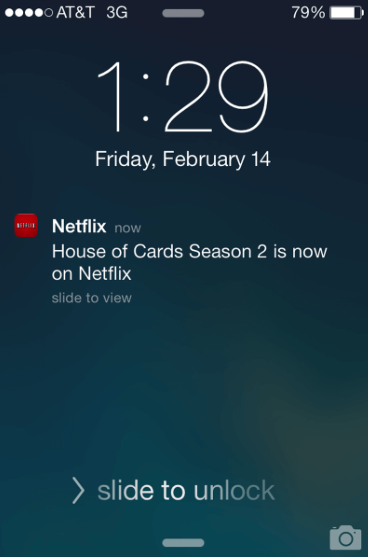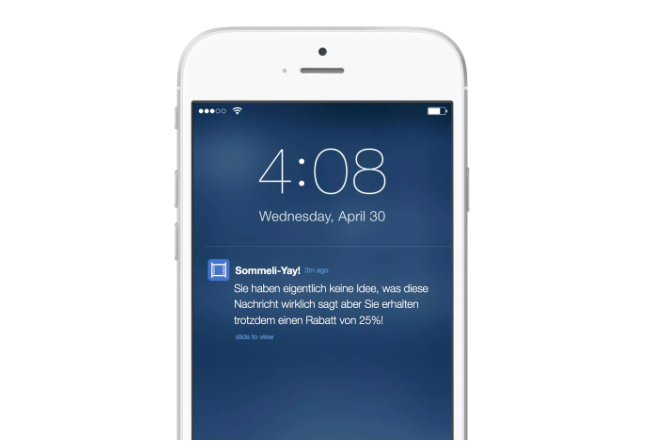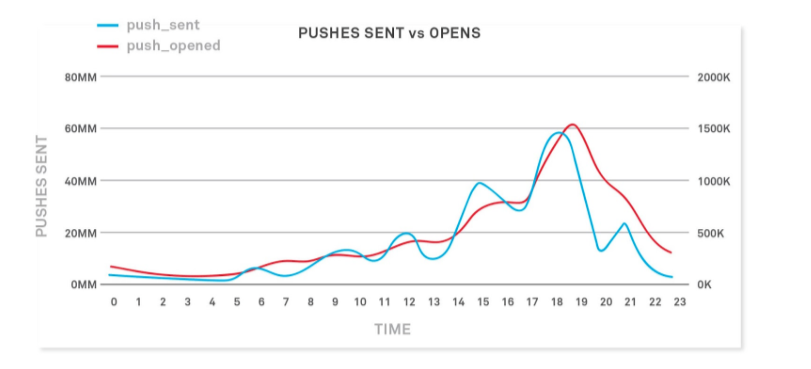Have you ever paid attention to the number of notifications you receive on a daily basis from various apps? How many of those notifications do you actually care about?
Everyday, we are bombarded with useless notifications that distract us from our day-to-day activities. Impersonal, irrelevant and poorly timed, they often force us to disable notification or even delete the app.

Annoying notifications is the #1 reason people uninstall mobile apps (according to 71% of survey respondents).
However, it’s possible to turn this anti-UX pattern into something meaningful and useful both for a business and for a user. To achieve good results with push notifications, designers simply need a publishing strategy that best fits this medium. Below are essential rules that should be followed when crafting a push notification strategy.
1. Avoid sending too many notifications in a short period of time
The most common mistake, and the most damaging from a usability point of view, while sending push notifications is sending users more notifications than they can handle. It’s important to remember that mobile is all about making every message count and increasing the frequency of notifications doesn’t necessarily increase the value of your app. Thus, don’t overwhelm users with push notifications, or they might end up deleting your app altogether.
To figure out the frequency of notifications, it’s critical to understand the audience, their lifestyles, and their needs.

All push notification arrived at the same moment. Updating your user with every action that has taken place is redundant.
2. Push the value
When a user starts using an app, they won’t mind getting notifications, as long as the value they get is sufficiently greater than the interruption. The problem is very few notifications deliver value.
Before sending a notification, it’s important to ask, “Do our users need this information?” This may sound absurd, but some notifications shouldn’t ever make it to a user’s screen:
- Don’t send push notifications just for the sake of “engaging users.” For example, Facebook routinely sends notifications inviting users to connect to randomly suggested people or to “Find more of your friends on Facebook.” This is a poor attempt entice users back into the app.
- Don’t push information your users can’t use. A successful push notification is always useful to the user. If your message is not helping your users (like in Spotify example below), you are sending a bad push notification.

Don’t thoughtlessly direct users back to the app.

Notifications mean little if what they deliver has no value to the user.
3. Personalize your message
Personalized content that informs, inspires, and delights is a critical component. Sometimes even a small detail, such as adding the receiver’s first name, can help push notifications perform better (in some cases up to 4x better). Of course, being personal doesn’t mean just adding user’s first name in the message. Personalizing the message content ensures that users receive information that is relevant and valuable to them. As Andrew Chen puts it:
“Focus on understanding what your users value about your service and tailor your messages to their unique needs and interests. You’ll see push engagement skyrocket, and your users transform into rabid advocates.”
Users appreciate content that is directly related to their personal interests. The best way to create a good personalized notification is good-old user data analysis. One great example of personalized notification can be found in Netflix apps for iOS and Android; Netflix carefully uses viewing data to present recommendations that feel tailor-made. Rather than sending every user a notification any time a new show or season is released, Netflix tracks the specific shows that each user has been watching, and only sends a notification to a user when one of their favorite shows has a new season available. The result: app notifies users with personal and relevant information.

Netflix does a great job of personalizing its push notifications, letting users know when their favorite shows are available.
Thus, when designing notifications, pay attention to product usage data, as well as any other information you have gathered about your users.
4. Keep the message clear and understandable
No matter what the content of the notification is, make sure it speaks the same language as its users (literally and figuratively).

Sending push notifications in German for the person who doesn’t speak this language is bad UX. Image credit: appboy
Also, don’t frustrate users with incomplete messages. Notification text should be fully readable in the notification block.

Avoid situations like this, because such messages don’t provide enough information for users.
Clear, accurate, and concise text makes notification messages more usable and builds trust.
5. Link to a valuable action
Most notifications are disconnected from the product experience; they lead generically into the app. Tapping them only lands users in the navigation menu, instead of starting a valuable action.
It’s important to connect push notifications to the target page or call to action button. A good example of an app that follows this rule is Busuu, a language-learning app. When users receive a notification and tap it, they are guided to a special and relevant page, which is the logical next step in the user journey.

Image credit: Antoine Sakho
6. Time your notification
Tailoring notifications to users isn’t just about the words and message; it’s also all about timing. Don’t send push notifications at odd hours. An ill-timed notification sent between 12:00 A.M and 6:00 A.M. risks waking up or disrupting users:

Of course, users could always disable notifications while they’re sleeping, but that’s not a good solution. A better solution would be to send notifications at times that would be most convenient and useful for users, unless it’s critical to inform them of something right away.
According to Andrew Chen’s research, it’s better to send push notifications between 6-8pm when engagement is at its highest. Don’t forget that 6-8 P.M. should be selected according to the user’s time zone!

Credit: Andrew Chen
Note: 6–8pm should only be taken as a rule of thumb. The timing of your push notification should also incorporate the urgency of the message. Great timing should consider both user behavior and urgency.

The notifications sent by United Airlines reference urgent and important information, and is tailored to the specific person receiving the message.
7. Test rigorously
Want to make a great push notification even better? Test it! A/B testing is incredibly useful for discovering out what message works the best for users.
Approaching Valentine’s Day, 1–800-Flowers prepared to A/B test two very different messages. They tested two versions of one message to a small sample of users who had added an item to their shopping carts but hadn’t completed their purchases.
The first message was a simple reminder:

The second version had a 15% off promotion code.

Contrary to what was expected, the first message — the version without a promotion code — performed better. The message without the promotion code generated 50% more revenue and resulted in fewer app uninstalls than the version with the promotion code. This is a great example of why testing is so important.
8. Measure real effectiveness of notification campaigns
Traditionally, push notifications have been measured by positive metrics such as open rates and click-through rates. These are good metrics, but they only tell half of the story. They won’t tell you whether users are getting the information they really need. They also won’t help find the answers to the following important questions:
- Did the user turn off notifications after a series of push notifications?
- Did a notification trigger someone to uninstall the app?
It’s better to have a big picture and track all corresponding metrics:
- App uninstalls: The number of app uninstalls that have been generated as a result of the notification campaign. When you are measuring this number in real time, it’s easy to adjust or cancel any detrimental notification campaigns before it’s too late.
- User engagement. Basically, this metric shows the number of users who re-engaged with your app after receiving the push notification.
9. Don’t limit yourself with push notifications
There are tons of notifications types and delivery methods, such as SMS, emails, and so on. It’s worth creating a simple notification map which matches each notification with the right priority.

Select the proper notification type based on the urgency and content. Image credits: Appboy
Make notifications useful!
Good notifications are relevant, timely and contextual. The best advice for notification designers is to respect the user’s time and attention, to do more with less.
Here are a few resources for further reading.
- Google’s Material guidelines for notifications
- UX Booth’s own Notification Design Strategies (oldie but goodie!)
- Designing Smart Notifications
- What Makes a Good Notification (by yours truly!)
Ready to get your feet wet in Interaction Design? In this article we touch briefly on all aspects of Interaction Design: the deliverables, guiding principles, noted designers, their tools and more. Even if you're an interaction designer yourself, give the article a read and share your thoughts.